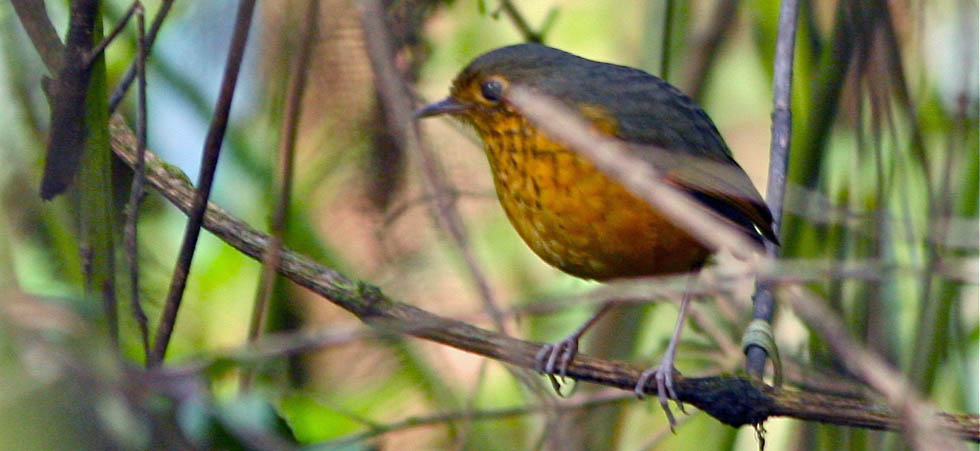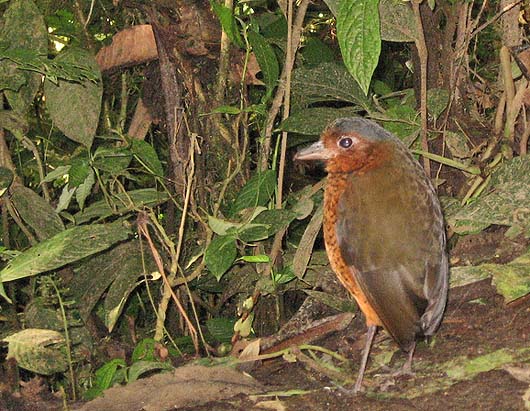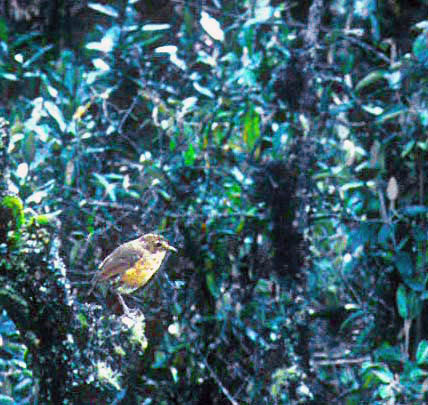
a web page by Don Roberson |
ANTPITTAS Grallariidae |
|
Antpittas have long been among the most sought-after of Neotropical birds, and among the most 'hopeless' to find was Giant Antpitta (left; nice photo by Jack Siler). Yes, one could sometimes tape in an antpitta, but things have changed in recent years. There are now spots in Ecuador, for example, where antpittas — even Giant Antpitta — can be enticed to feed on earthworms offered by local guides. Antpittas typically feed alone, although pairs are typically in touch vocally. They eat a wide variety of prey, from earthworms and other terrestrial invertebrates to frogs and, sometimes, fruit. Many species bob their heads or flick their tails.
|
| Antpittas were once considered part of the huge Antbird family [Thamnophilidae]; indeed, the groups remained merged through the 20th century. All these birds are found only in the Neotropics. By the time that the Handbook of the Birds of the World series reached the suboscines, there was enough published evidence to split the unique "ground-antbirds" — the antpittas and the antthrushes — from the rest of the antbirds, and the "ground-antbirds" appeared together in HBW as a new family, the Formicariidae (Krabbe & Schulenberg 2003). Those authors, however, were already citing new genetic work that would lead to a quick break-up of the "ground-antbird" assemblage. |
Recent genetic work (e.g., Irestedt et al. 2002, Chesser 2004b, and others) showed that there were three distinct lineages in the "Formicariidae." The South American and North American checklist committees have handled this by restricting Formicariidae to just two genera of antthrushes [Formicarius, Chamaeza]; creating the family Grallariidae for all antpittas except the genus Pittasoma, and assigned the two species of Pittasoma antpitta to the Gnateaters [Conopophagidae; a bit more on that below]. Thus our group here — Antpittas, family Grallariidae — is now composed of 55 species in four genera. The very large antpittas — such as Giant Antpitta shown above — are in the genus Grallaria. The rest are smaller antpittas, and many are more prone to perches about ground level, including Streak-chested Antpitta of Central America and northern South America (right, in a nice photo by Greg Lasley). It is a Hylopezus antpitta, and together with the Myrmothera antpittas, they are the mid-sized birds in the Antpitta family. There are 10 species of Hylopezus antpittas in the Neotropics; the representative in the Atlantic forests of southeast Brazil, and adjacent Paraguay and Argentina, is Speckle-breasted Antpitta (below). This is a very shy bird of montane undergrowth. It took about an hour to get a view of this individual. |
 |
All antpittas have comparatively dull-colored plumages, although some combinations of rufous, black, and gray are very attractive. All are predominately terrestrial birds, and camouflage is important to them. Instead, vocalizations have largely taken over the role in signaling functions. "Their exotic, ventriloquial, loud, and often easily imitated whistled songs are so low-pitched that they travel along the ground for considerable distances" (Krabbe & Schulenberg 2003). The majority of territorial disputes are settled vocally, and pair bonds are emphasized by voice. In the humid lowlands, most vocalizations are given at dawn or dusk, but high elevation species, like Tawny Antpitta, may sing throughout the day. |
Among them are some of the rarest Neotropical birds, and some only recently discovered. Cundinamarca Antpitta G. kaestneri was discovered by Peter Kaestner in Colombia in the 1980s, and Bob Ridgely discovered the spectacular Jocotoco Antpitta G. ridgelyi in southern Ecuador in the 1990s. Both birds were initially recognized as something different by voice; both are now considered endangered species with very small ranges. A final thought about two species of Pittasoma antpittas [Black-crowned Antpitta P. michleri, Rufous-crowned Antpitta P. rufopileatum]. These are huge ground birds that differ from Grallaria antpittas in plumage pattern (more striking, less dull) and sternal structure, and are genetically closest to the Conopophaga gnateaters. Accordingly, the AOU and SACC committees have assigned them to the Gnateater family [Conopophagidae]. This feels like a temporary solution to me: the two Pittasoma antpittas are huge compared to the tiny gnateaters, and they don't behave like gnateaters. Might they deserve their own family? |
Photos: Jack Siler photographed the Giant Antpitta Grallaria excelsa in the Mindo region of Ecuador in Sep 2008. Greg Lasley photographed the Streak-chested Antpitta Hylopezus perspicillatus at Braulio Carillo National Park, Costa Rica, in Nov 1991. The Speckle-breasted Antpitta Hylopezus nattereri was at upper elevations in Itatiaia NP, Brazil, on 5 Aug 2020. The Tawny Antpitta Grallaria quitensis was at Papallacta Pass, Ecuador, in April 1992. Family Book:
In addition, a fine introduction to this family, with some great photos, is in Krabbe & Schulenberg (2003), Unfortunately, at that time (2003), the antpittas were lumped with antthrushes. The authors discuss all the evidence then available (e.g., Irestedt et al. 2002) and anticipate the results of others (e.g., Chesser 2004). Thus the overview on Antpittas is quite current there, despite the now-discarded merger with antthrushes. Literature cited:
|
 There
is something very special about the forest floor in primeval jungles.
It is dark, often damp, and mysterious. In the Neotropics it is the
home of jaguars, tapirs, ground-cuckoos, and antpittas. I love standing
alone in the gloom, hoping to see any of these inhabitants. They are
difficult to see, but they are central to a forest experience.
There
is something very special about the forest floor in primeval jungles.
It is dark, often damp, and mysterious. In the Neotropics it is the
home of jaguars, tapirs, ground-cuckoos, and antpittas. I love standing
alone in the gloom, hoping to see any of these inhabitants. They are
difficult to see, but they are central to a forest experience. 
 The largest genus in the family is Grallaria, with 32 species. These range from mid-sized birds at high elevations, such as Tawny Antpitta
(left), to the very
large antpittas of the lowlands. Tawny Antpitta is the exception to the "general rule" that antpittas are secretive and hard-to-see. Up in the elfin forest, where this photo was taken at 4000m (13,000'), this species was bold, often perching up or hopping on the ground in the open. The ease of seeing this species is very unlike all other antpittas.
The largest genus in the family is Grallaria, with 32 species. These range from mid-sized birds at high elevations, such as Tawny Antpitta
(left), to the very
large antpittas of the lowlands. Tawny Antpitta is the exception to the "general rule" that antpittas are secretive and hard-to-see. Up in the elfin forest, where this photo was taken at 4000m (13,000'), this species was bold, often perching up or hopping on the ground in the open. The ease of seeing this species is very unlike all other antpittas.